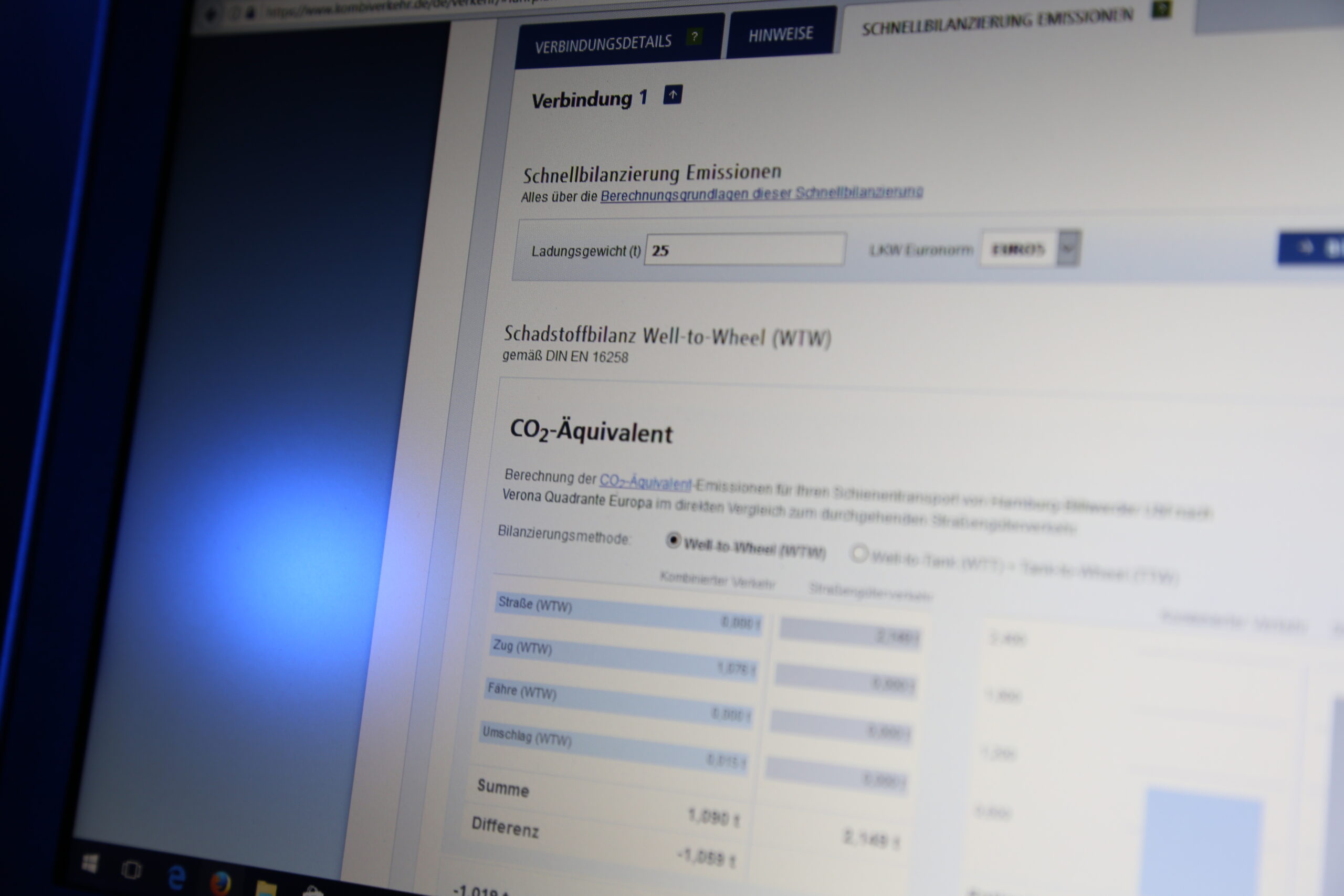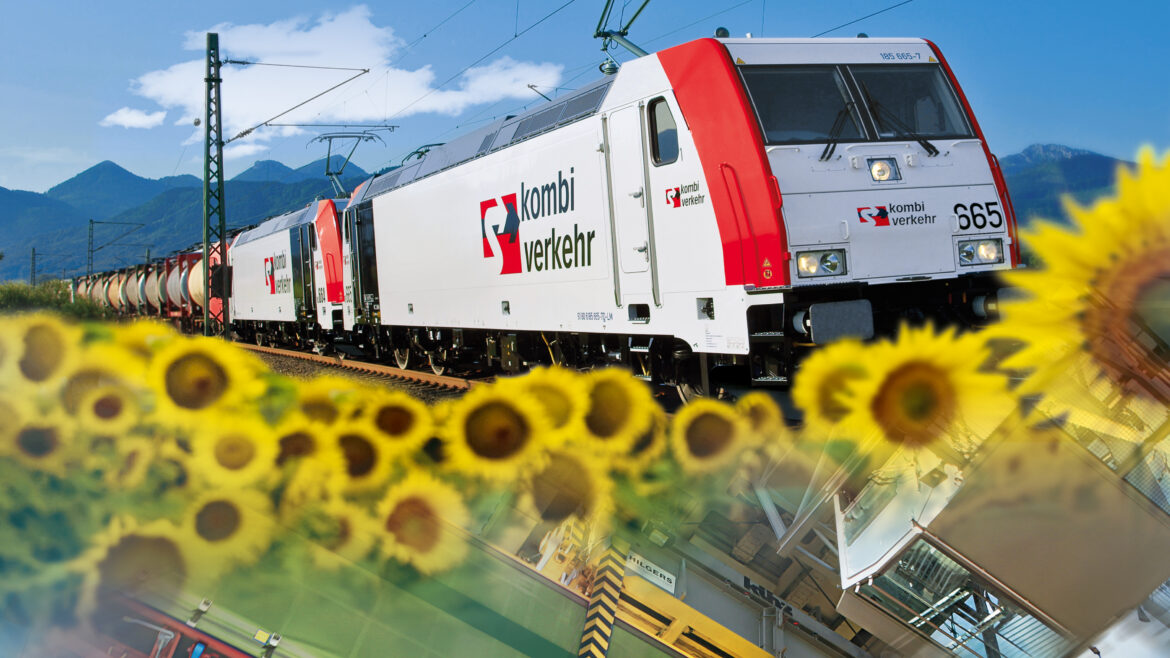“How many pollutant emissions do we actually save by using Combined Transport?” Carriers are asking forwarders and hauliers this question with ever-increasing frequency because they want the ecological benefits of Combined Transport to be incorporated into their environmental balance. To answer this question, forwarders and hauliers need a simple calculation of transport-related pollutant emissions – which is why Kombiverkehr has integrated a ready reckoner into the online timetable information on its own website at www.kombiverkehr.com.
The digital “pollutant calculator” can be used to calculate emissions savings on an individual basis: for every single shipment, for individual routes and for total annual volumes. And all it takes is a few mouse clicks. The software tool takes seconds to compare the pollutant emissions of intermodal transport with those of end-to-end road haulage on individually plannable routes – not only the greenhouse gas CO2 but also, for example, nitrogen oxide, sulphur dioxide, non-methane hydrocarbons and fine dust. The program can be used free of charge.
“The quick calculator for pollutant emissions allows us to make the main benefits of CT transparent: green arguments in black and white,” says Kombiverkehr managing director Armin Riedl. “The application is particularly useful for forwarding companies if their own calculations are too complex or if they lack the time, material data and know-how to work out the figures.”
Armin Riedl, Managing Director of Kombiverkehr KG
When it comes to the quick calculation of pollutant emissions, Kombiverkehr relies on the renowned Institute for Energy and Environmental Research (IFEU) in Heidelberg, which supplies the database. When processing emissions data, IFEU refers to public sources such as the “Handbook Emission Factors for Road Transport” (HBEFA), data from the “Assessment and Reliability of Transport Emission Models and Inventory Systems” (ARTEMIS) project or the “ecoinvent” database. It also makes use of a geoinformation system. The calculation standard is EN 16258.
„Wir bilanzieren die Umwelt-Auswirkungen des Güterverkehrs in Bezug auf den direkten wie auf den indirekten Energieverbrauch, das heißt, wir beziehen bei der Berechnung auch solche Emissionen mit ein, die bei Erzeugung, Transport und Verteilung der für den Betrieb der Fahrzeuge nötigen Energie anfallen. Also ein Gesamtblick auf den KV-bedingten Footprint.“

Ready reckoner for pollutant emissions: The internet application at www.kombiverkehr.de uses clear tables and diagrams to show users the emissions for five different pollutants as well as primary energy consumption.
How much is actually saved
The comparison figures for the following two examples relate to 1500 tons laden weight, a truck with a total weight of 34 to 40 tons and the Euro 5 truck emissions standard. Users can change the settings in line with their vehicle fleet and individual laden weights.
Hamburg-Billwerder – München-Riem
On this route, CT saves 61 tons or 73 per cent CO2 compared with road freight transport alone. The selected train service covers a distance of 787 km, whilst the truck covers 776 km on the direct trip. And these are the savings for other pollutants, together with the reduction in primary energy consumption measured in litres of diesel equivalent:
0.603 t nitrogen oxide (94 per cent)
0.026 t sulphur dioxide (25 per cent)
0.058 t non-methane hydrocarbons (92 per cent)
0.013 t fine dust (69 per cent)
19,012 litres of diesel equivalent (55 per cent)
München-Riem – Madrid
On this route, CT saves 144 tons or 67 per cent CO2 compared with road freight transport alone. The selected train service covers a distance of 2,557 km, whilst the truck covers 2,001 km on the direct trip. The savings for other pollutants, together with the reduction in primary energy consumption measured in litres of diesel equivalent:
1.532 t nitrogen oxide (93 per cent)
0.019 t sulphur dioxide (7 per cent)
0.148 t non-methane hydrocarbons (91 per cent)
0.031 t fine dust (63 per cent)
39,063 litres of diesel equivalent (43 per cent)
IFEU Institut Heidelberg
The IFEU Institute in Heidelberg is the place to go when comparing modes of transport according to their emissions. IFEU devised the Transport Emission Model (TREMOD) and TREMOD shows that every truckload shifted onto the railway reduces CO2 by 60 g per t and km compared with transport by road alone. Combined Transport also proves to be the most environmentally friendly form of transport in relation to nitrogen oxides, hydrocarbons and primary energy consumption. TREMOD is used by the German Environment Agency and the federal Ministry of the Environment, Nature Conservation and Nuclear Safety, among others. European standard 16258 applies to emissions comparison.
By the way, Kombiverkehr also advocates the use of quiet brakes
Braking systems on modern freight wagons reduce the noise emissions of a train by approximately 10 decibels – so it now sounds half as loud as before. This is already a feature of all freight wagons approved after 2006, as their brake blocks consist of a composite material rather than cast iron. Kombiverkehr has retrofitted older models to ensure that all the wagons in use today have quiet brakes, thus complying with the noise control requirements that apply to goods wagons from 2021.


Comments are closed.